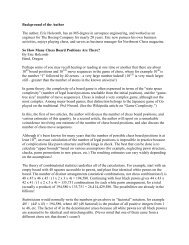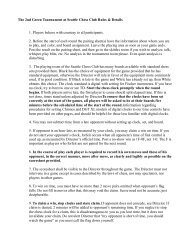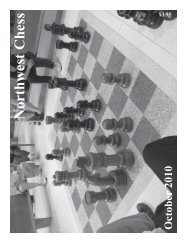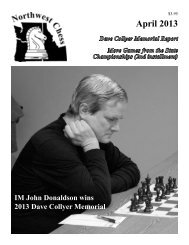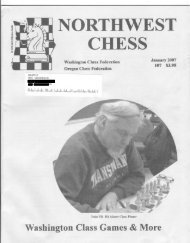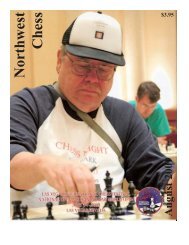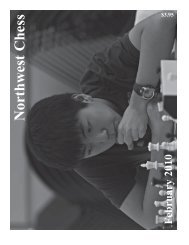Create successful ePaper yourself
Turn your PDF publications into a flip-book with our unique Google optimized e-Paper software.
PROTECTING - THE DEFENSIVE METHODThis method is used quite often – first, to protect one of your men; second, to protect oneof your squares. Concern<strong>in</strong>g the first reason – In this case he may capture your man, soyou should be sure that your man is weaker than any man of his that is attack<strong>in</strong>g it,otherwise he can ga<strong>in</strong> material by trad<strong>in</strong>g. As an example, if he attacks your queen withhis rook, bishop, or knight, then it would be wrong to protect your queen. <strong>The</strong> sameapplies when he attacks any of your men with his weakl<strong>in</strong>gs (pawns). Another th<strong>in</strong>g towatch for is this: he is attack<strong>in</strong>g your man with two of his men, then you must protectyour man twice, or he will come out ahead if he trades. Now for an example:1. P-K4 P-K4 (e4 e5)2. N-KB3 N-QB3 (Nf3 Nc6)3. B-QN5 P-Q3 (Bb5 d6) Ruy Lopez, Old Ste<strong>in</strong>itz Defense!4. P-Q4 PxP (d4 exd4)5. NxP ... (Nxd4 …)If you look this position over carefully, <strong>in</strong> accordance with lesson one, what are white’sthreats? We will take this open<strong>in</strong>g move by move.1. P-K4 P-K4 (e4 e5)2. N-KB3 ... (Nf3 …)Black can see that white is threaten<strong>in</strong>g NxKP (Nxe5), so he protects his KP.2. … N-QB3 (… Nc6)3. B-QN5 … (Bb5 …)Black protected his KP with his QN, and now white’s last move is another threat: whitethreatens BxN (Bxc6) but black has this knight well protected with his QNP and QP,BUT this Knight is protect<strong>in</strong>g his KP, so naturally if white trades it off, then black willnot have any protection for his KP, so:3. … P-Q3 (… d6)and black’s KP is quite safe; however, notice now that black cannot move his QN, it isPINNED by white’s bishop, and if it moved this white bishop would be check<strong>in</strong>g thek<strong>in</strong>g.4. P-Q4 PxP (d4 exd4)White attacked the KP once more, and black was glad to trade it off, as this DID AWAYWITH WHITE’S THREAT.5. NxP … (Nxd4 …)As the black knight on QB3 (c6) cannot move; it was perfectly safe for white to play 5.QxP (Qxd4), but white chose the knight, as now he is threaten<strong>in</strong>g to capture black’sknight TWICE, with his bishop and his knight. Notice that black is protect<strong>in</strong>g his knightwith only one th<strong>in</strong>g, his QNP. So white is threaten<strong>in</strong>g 6. NxN, PxN (Nxc6 bxc6); 7. BxPcheck! (Bxc6+!) and 8. BxR (Bxa8) and white will be material ahead. Notice that whitecaptured first with his knight, so that he would have his bishop left to make the f<strong>in</strong>alcapture.So this is white’s threat, and now what is black to do? He can’t capture, he can’t<strong>in</strong>terpose, and he can’t move his knight, so it follows that he must protect his knight oncemore: so he plays:
5. … B-Q2! (… Bd7)White wants to keep his threats, so he doesn’t destroy them by captur<strong>in</strong>g; black wants todestroy white’s threats, so he does want to capture.6. Castles NxN (o-o Nxd4)7. BxB ch ... (Bxd7+ …)White must do this first, as black was threaten<strong>in</strong>g to play 7. --- BxB (… Bxb5). Whiteknows his lesson one, so he looked for ALL black’s threats; if he hadn’t, he might nothave seen that black’s bishop was threaten<strong>in</strong>g to capture white’s bishop. White usesmethod one here, as it destroys the threat, and still leaves him with the move, so now hecan recapture the knight.7. … QxB (… Qxd7)8. QxN N-KB3 (Qxd4 Nf6)9. B-KN5 ... (Bg5 …)Now white has another threat, he threatens 10. BxN, PxB (Bxf6 gxf6); 11. QxKBP(Qxf6), w<strong>in</strong>n<strong>in</strong>g a pawn. Black must answer this threat. Here he can move the knight, butthat would be bad, because the knight has no place to go. (If the knight moves, he will beattacked by white and chased home.) He can’t <strong>in</strong>terpose, and he can’t capture white’sbishop, so he must protect; he plays:9. … B-K2 (… Be7)10. N-QB3 Castles (Nc3 o-o)11. N-Q5 ... (Nd5 …) Forc<strong>in</strong>g too many captures?Aga<strong>in</strong> white threatens. He has three men attack<strong>in</strong>g black’s knight, and black has only twomen protect<strong>in</strong>g his knight, so aga<strong>in</strong> he must answer the threat. Black looks for ways ofanswer<strong>in</strong>g this threat, and he sees that he can capture, thus destroy<strong>in</strong>g the threat for good,and it will still be his move, so he plays:11. … NxN (… Nxd5)12. QxN … (Qxd5 …)Not 12. BxB?, NxB (Bxe7? Nxe7) and black is a man ahead. White answers black’sthreat of BxB (Bxg5) by protect<strong>in</strong>g his bishop.12. … BxB (… Bxg5)13. QxB … (Qxg5 …)Now black has destroyed all of white’s threats, and he hasn’t lost any material, and it ishis move, and he looks for ways to attack white. He sees that white has no protection forhis KP, or his QBP, so he plays:13. … Q-QB3 (… Qc6)attack<strong>in</strong>g both these pawns, and he will later play his rooks onto the k<strong>in</strong>g file (R-Kl(Re8), R-K4 (Re5) etc.), and he has a very good game.<strong>The</strong> important th<strong>in</strong>g to notice <strong>in</strong> this example is that black used his bishop to protect hisknights, when white attacked them by the usual moves of B-N5 (Bb5 or Bg5). <strong>The</strong>n hecould move his knight, attack<strong>in</strong>g white’s bishop, thus destroy<strong>in</strong>g the threats very quickly.Also, black was careful to destroy white’s threats just as soon as he could. Black wascareful not to waste time mak<strong>in</strong>g pawn moves, as it is only necessary to move two pawnsto get the two bishops out, and other pawn moves only weaken the pawns. Remember
this, and see if it isn’t true <strong>in</strong> the games you play. In protect<strong>in</strong>g men, we use pawns, ifpossible, as to use a queen to protect a knight, <strong>in</strong>stead of a pawn, or a bishop, would meanthat you couldn’t use your queen for anyth<strong>in</strong>g else. Always remember that if one of yourmen is protect<strong>in</strong>g another man, then your first man must not move, else he will leave yourother man unprotected.In the game we have just left, white could cont<strong>in</strong>ue to attack, thus, after:13. … Q-QB3 (… Qc6)14. P-KB4 QxKP (f4 Qxe4)15. P-KB5 QxQBP (f5 Qxc2)16. P-KB6! … (f6 …)This is a terrible threat!! White threatens 17. QxNP MATE (Qxg7++). How is black toanswer this threat? His k<strong>in</strong>g cannot run, as he is caught by his KR. So he must face thethreat. He can’t capture (PxP (gxf6) is impossible), but he can move his KNP (g6), thus<strong>in</strong>terpos<strong>in</strong>g it between white’s queen and the mat<strong>in</strong>g square, but white plays 17. Q-R6!!(Qh6!!), and this time there is no answer. But all along black saw that his queen was onthe right diagonal, and now he can protect the mat<strong>in</strong>g square (his KN2 (g7)) with hisqueen by:16. … Q-KN3 (… Qg6), thus sav<strong>in</strong>g the game. (… Qc5+ also works)This illustrates the idea of protect<strong>in</strong>g your weak squares. You should be on guard,especially around your k<strong>in</strong>g, to protect any square that is weak. Most payers are neveraware that any of their squares are weak! In my game with W.H. Smith, he made his KB3(f6) square weak by play<strong>in</strong>g P-KN3 (g6), and then he didn’t protect this weak square, andsoon I was occupy<strong>in</strong>g his weak square!! Naturally it is best to protect your weak squareswith pawns. This is the ma<strong>in</strong> reason you shouldn’t advance your pawns, because itusually leaves weak squares. This is especially true of the pawns <strong>in</strong> front of your castledk<strong>in</strong>g. Remember this idea of WEAK SQUARES, it is very important. In our next lessonwe will take up the fifth way to answer threats. We have gone <strong>in</strong> pretty deep <strong>in</strong> thislesson, and I hope that you have had the patience to study it carefully. Try to get thegeneral idea of each of these four ways of answer<strong>in</strong>g threats. Good luck!





